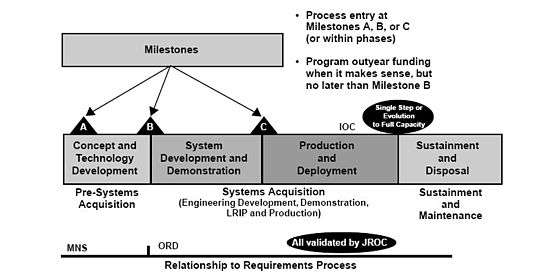Military acquisition

Military acquisition is the bureaucratic management and procurement process dealing with a nation's investments in the technologies, programs, and product support necessary to achieve its national security strategy and support its armed forces. Its objective is to acquire products that satisfy specified needs and provide measurable improvement to mission capability at a fair and reasonable price.[1]
Concept
Military acquisition has a long history spanning from ancient times (e.g., blacksmithing, shipbuilding) to modern times.
Modern military acquisition is a complex blend of science, management, and engineering disciplines within the context of a nation's law and regulation framework to produce military material and technology. This complexity evolved from the increasing complexity of weapon systems starting in the 20th century. For example, the Manhattan Project involved more than 130,000 people at an estimated cost of nearly $24 billion in 2008 dollars.
In the twenty-first century, the trend has been for countries to cooperate in military procurement, due to the rising cost-per-unit of digital age military hardware such as ships and jets. For example, NORDEFCO (established 2009), a grouping of Nordic countries that cooperate in defence spending, the Defence and Security Co-operation Treaty, signed between the United Kingdom and France in 2010, and Joint Strike Fighter program, which selected the Lockheed Martin F-35 Lightning II in 2001, included the United States, the United Kingdom, Australia, Italy, Canada, the Netherlands, Norway, Denmark, Turkey, Israel and Japan.
Activities
Major activities related to military acquisition are:
In the European Union
EU member states' procurement of arms, munitions, war material and related works and services acquired for defence purposes and procurement of sensitive supplies, works and services required for security purposes are subject to EU Directive 2009/81/EC on Defence and Sensitive Security Procurement.[2] The purpose of the directive is to balance the need for transparency and openness in defence markets within the European Single Market with the need to protect individual countries’ security interests.[3]
In the United States
The US Department of Defense has three principal decision-making support systems associated with military acquisition:[1][4]
- Planning, Programming, Budgeting and Execution (PPBE) Process – Process for strategic planning, program development, and resource determination.
- Joint Capabilities Integration and Development System – The systematic method established by the Joint Chiefs of Staff for assessing gaps in military joint warfighting capabilities and recommending solutions to resolve these gaps.
- Defense Acquisition System [5][6] – The management process used to acquire weapon systems and automated information system.
Because of the size and scope of such a bureaucracy, the US Department of Defense instituted an extensive training program, known as the Defense Acquisition University.
See also
- Analysis of Alternatives
- Defence Equipment and Support (UK)
- Defence Materiel Organisation (Australia)
- Defense Acquisition University (US)
- Integrated Logistics Support
- Joint Capabilities Integration Development System
- Logistics Support Analysis
- Procurement
- Under Secretary of Defense for Acquisition, Technology and Logistics
- Government procurement - includes details of relevant procurement law affecting defence procurement in a number of other states
References
- 1 2 Defense Acquisition Guidebook, US Department of Defense, Nov 2004
- ↑ [Directive 2009/81/EC of the European Parliament and of the Council of 13 July 2009 service contracts by contracting authorities or entities in the fields of defence and security, and amending Directives 2004/17/EC and 2004/18/EC], accessed 9 June 2018
- ↑ European Commission, Defence procurement, accessed 9 June 2018
- ↑ "Integrated Defense Acquisition, Technology and Logistics Life Cycle Management System Chart", Defense Acquisition University, 28 Jan 2009
- ↑ "The Defense Acquisition System", US DoD Directive Number 5000.1 (DoD D 5000.1), 12 May 2003
- ↑ "Operation of the Defense Acquisition System", US DoD Instruction Number 5000.2 (DoD I 5000.1), 12 May 2003 "Archived copy" (PDF). Archived from the original (PDF) on 2010-10-10. Retrieved 2010-09-10.
External links
| Look up military acquisition in Wiktionary, the free dictionary. |
| Wikimedia Commons has media related to Military acquisition. |
- Assistant Secretary of the Air Force for Acquisition (ASAF (A))
- Assistant Secretary of the Navy for Research, Development & Acquisition (ASN (RDA))
- Defense Acquisition History Project
- Defense Procurement News
- United States Assistant Secretary of the Army for Acquisition, Logistics, and Technology (OASA(ALT))
- Defense Acquisition University ACC Practice Center